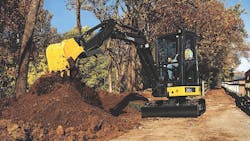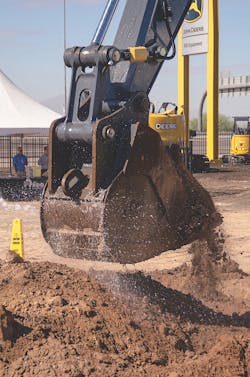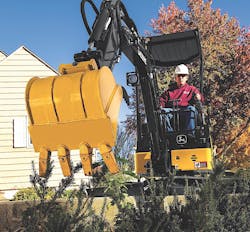Equipment is the lifeblood of a rental center. Ensuring all customers understand proper operation, care, and safety responsibilities that go with machines they’re renting not only benefits them, but pays back the rental center in customer satisfaction and reduced fleet management costs.
Customers also have vested interest in caring for and operating machines safely and properly, making it wise for even the most seasoned equipment operator to stay up-to-date on technique tips and regularly brush up safety practices.
Fresh off the National Safety Council’s Safety Month in June, and as workers head into the peak of summer – with long days on the jobsite demanding focus and tight timelines demanding efficiency – what better time for every rental center to take a little refresher lesson in compact excavator tips.
The following three areas are key to review with renters to ensure proper and safe operation of a compact excavator.
Simple safety
Don’t let their size fool you – compact excavators pack a lot of punch and power. While a smaller machine, it deserves just as big a focus on safety as a crane, dozer or other large jobsite staple.
Did you know most incidents happen, not during operation, but during the loading and unloading of the machine? The best safety tip for avoiding transport troubles is to use caution when loading and unloading, and ensure the boom is always facing the direction it’s being moved.
Another safety precaution comes before even starting up the excavator: slips and falls from the machine. To prevent these types of accidents, remind renters to always maintain three points of contact with the machine when getting in and getting out.
Finally, ensure the excavator operator knows which control pattern the machine is in prior to operation to avoid improper direction and movements of the boom and bucket.
Workday 101
Before the operator sets foot in the machine, during operation, and prior to calling it a day, a few best practices should be part of each workday with a compact excavator.
Encourage renters to do a quick pre-operation inspection of the machine at the start of each day. An easy program might include things like checking the tracks, looking for any areas that appear to be damaged, cleaning mirrors and replacing any that are broken, and ensuring all fluids are at adequate levels.
When in the cab and ready to operate, it’s imperative the operator is alert and aware of surroundings, including structures, different types of terrain, and other machines working on the jobsite. Operators should adjust accordingly for smooth traffic flow, efficient operation, and safety. And most importantly, watching for and always yielding to people on the worksite.
At the end of the day, it’s tempting for renters to simply shut down the excavator and go home. Let them know a few extra minutes spent on addressing two items pay back big time in productivity and reduced downtime.
First, fuel up the excavator at the end of each day. It’s one less thing to worry about the next morning, but more importantly, a full fuel tank leaves little room for condensation in the tank and system. Condensation can ruin fuel and cause problems in the engine so this one simple practice can save time and money caused by wasted fuel and costly repairs.
End-of-day is also prime time to address any points that need grease. Again, not only does it save a step the next morning, the bushings and pins are more receptive to grease when warm, after a long day of work, than when they’re cold, prior to machine start-up in the morning.
Expert execution
Every operator can benefit from drawing on experience of others. Here are a few tips from the experts at RDO Equipment Co.
- “To achieve faster cycle times when using a bucket, go into the dirt at a 45-degree angle, and come out at a 45-degree angle.”
Kenny Lopez, rental sales professional
- “Most John Deere compact excavators have an automatic shift feature that essentially acts as an automatic transmission. If you leave the tracking speed in high, it will automatically shift to low when under pressure, then return to high as you straighten back up again. Other brands, you have to manually shift but these do it on their own.”
-- Tory Williams, product specialist
- “Increase productivity by placing spoils close to where you’re digging versus taking the time to rotate and put them behind or further away.”
-- Robert Mommsen, CWP sales professional
A successful season
At the peak of the busy summer season, a quick review of safety and operational tips with all compact excavator renters can be the difference in a frustrated customer and a satisfied one. Arm your customers with a few basic tips and you’re both likely to end up happy in the end.
Jason Riley is a Demo Specialist with RDO Equipment Co. He is based in Phoenix.


